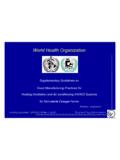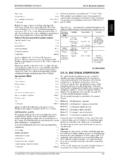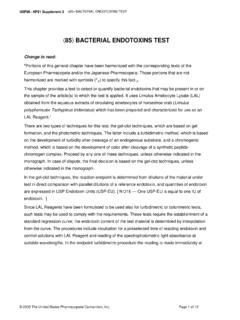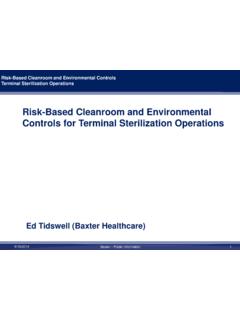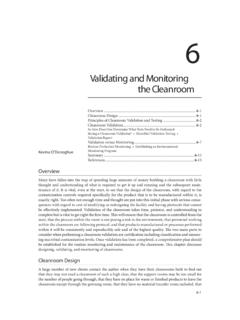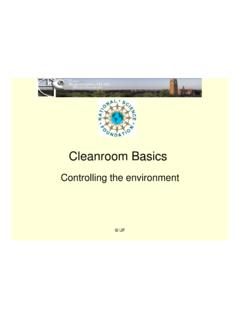Transcription of Cleanroom For Sterile Manufacturing Facilities - …
1 CleanroomForSterile Manufacturing FacilitiesPraphon AngtrakoolFood and Drug AdministrationWHO TRS No. 823 Annex 1, 1992(1) The production of Sterile preparations should be carried out in clean areas, entry to which should be through airlocks for personnel and/or for goods. Clean areas should be maintained to an appropriate standard of cleanliness and supplied with air that has passed through filters of an appropriate The various operations of component preparation (such as containers and closures), product preparation, filling and sterilization should be carried out in separate areas within a clean Clean areas for the production of Sterile products are classified according to the required characteristics of the air,in grades A, B, C and D (see Table 1)1 WHO TRS No. 823 Annex 1, 1992(2)50020 0003 500 000D1002 000350 000C5 None3 500 BLess than 1 None3 500A(Laminar airflow workstation)> 5 5 mMaximum number of viable micro-organism per m3 Maximum number of particle permitted per m3 GradeTable 1.
2 Air classification system for manufacture of Sterile products2 WHO TRS No. 823 Annex 1, 1992(3)GeneralTo obtain air of the required characteristics, methods specifiedby the national authorities should be used. It should be noted that: Laminar airflow systems should provide a homogeneous air speed of about m/s for vertical flow and about m/s for horizontal flow but precise air speeds will depend on the type of equipment. In order to reach the B, C and D air grades, the number of air changes should generally be higher than 20 per hour in a room with a good airflow pattern and appropriate HEPA (high-efficiency particulate air) TRS No. 823 Annex 1, 1992(4)General Low values for contaminants are reliable only when a large number of air samples are taken. The guidance given for the maximum permitted number of particles corresponds approximately to the United States Federal Standard 209 E (1992) as follows : Class 100 (grades A and B), Class 10 000 (grade C), and Class 100 000 (grade D)It may not always be possible to demonstrate conformity with particular air standards at the point of fill when filling is inprogress, owing to the generation of particles or droplets from the product of Sterile Manufacturing operations are here divided into three categories: first, those in which the preparation is seal in its final container and terminally sterilized; second, those in which the preparation issterilized by filtration.
3 And third, those in which the preparation can be sterilized neither by filtration nor terminally and consequently must be produced from Sterile starting materials in an aseptic way. Area grades as specified in section , must be selected by the manufacturer on the basis of validation runs ( , Sterile media fills)WHO TRS No. 823 Annex 1, 1992(5)5 WHO TRS No. 823 Annex 1, 1992(6)Terminally sterilized Solutions should generally be prepared in a grade C environment in order to give low microbial and particulate counts, suitable for immediate filtration and sterilization. Solution preparation could be allowed in a grade D environment if additional measures were taken to minimize contamination, such as the use of closed vessels. For parenterals, filling should be done in a laminar airflow workstation (grade A) in a grade C environment.
4 The preparation of other Sterile products, , ointments, creams, suspensions and emulsions, and filling of containers should generally be done in a grade C environment before terminal TRS No. 823 Annex 1, 1992(7) The handling of starting materials and all further processingshould be done in a grade A or B area with a grade B or C background Sterile filtered products prepared from Sterile materials in an aseptic way7 WHO TRS No. 823 Annex 1, 1992(8)Grade A or B (Background Grade B or C respectively)Grade CGrade CPreparation and filling of ointments, emulsions, creams and suspensionsGrade A or B (Background Grade B or C respectively)Grade A or B (Background Grade B or C respectively)Grade A Background Grade C (Parenteral)FillingGrade A or B (Background Grade B or C respectively)Grade C oruse closed vessels in Grade D BackgroundGrade C oruse closed vessels in Grade D BackgroundPreparation of solutionsGrade A or B (Background Grade B or C respectively)Grade C oruse closed vessels in Grade D BackgroundGrade C oruse closed vessels in Grade D BackgroundHandling of Sterile starting materialsAseptically ProcessedSterile FilteredTerminally SterilizedTypical Process StepTypical Air Quality Classification (WHO TRS 823, 1992)
5 8 PIC/S,1 July 2004 (1) manufacture of Sterile products should be carried out in clean areas, entry to which should be through airlocks for personnel and/or for equipment and materials. Clean areas should be maintained to an appropriate cleanliness standard and supplied with air which has passed through filters of an appropriate various operations of component preparation, product preparation and filling should be carried out in separate areas within the clean area. Manufacturing operations are divided into two categories; firstly those where the product is terminally sterilised, and secondly those which are conducted aseptically at some or all , TRS 902 Annex 6, 2002 (1) The production of Sterile preparations should be carried out in clean areas, entry to which should be through airlocks for personnel and/or for equipment and materials.
6 Clean areas should be maintained to an appropriate standard of cleanliness and supplied with air that has passed through filters of the required The various operations of component preparation (such as those involving containers and closures), product preparation, fillingand sterilization should be carried out in separate areas withina clean area. These areas are classified into four grades (see section ). Manufacturing operations are divided here into two categories: first, those where the product is terminally sterilized, and second, those which are conducted aseptically at some or all ,1 July 2004 (2)GENERAL3 Clean areas for the manufacture of Sterile products are classified according to the required characteristics of the environment. Each Manufacturing operation requires an appropriate environmental cleanliness level in the operational state in order to minimize the risks of particulate or microbial contamination of the product or materials being order to meet in operation conditions these areas should be designed to reach certain specified air-cleanliness levels in the at rest occupancy state.
7 The at rest state is the condition where the installation is installed and operating, complete withproduction equipment but with no operating personnel present. The in operation state is the condition where the installation is functioning in the defined operating mode with the specified number of personnel , TRS 902 Annex 6, 2002 (2)4. Manufacture of Sterile Clean areas for the manufacture of Sterile products are classified according to the required characteristics of the environment. Each Manufacturing operation requires an appropriate environmental cleanliness level in the operational state in order to minimize the risks of particulate or microbiological contamination of the product or materials being order to meet in operation conditions, these areas should be designed to reach certain specified air cleanliness levels in the at rest occupancy state.
8 This latter state is the condition where the installation is complete, and production equipment has been installed and is operating, but no operating personnel are present. The in operation state is the condition where the installation is functioning in the defined operating mode and the specified number of personnel are ,1 July 2004 (3)GENERALFor the manufacture of Sterile medicinal products 4 grades can be A: The local zone for high risk operations, filling zone, stopper bowls, open ampoules and vials, making aseptic connections. Normally such conditions are provided by a laminar air flow work station. Laminar air flow systems should provide ahomogeneous air speed in a range of m/s (guidance value) at the working position in open clean room applications. The maintenance of laminarity should be demonstrated and validated.
9 A uni-directional air flow and lower velocities may be used in closed isolators and glove B: For aseptic preparation and filling, this is the background environment for grade A Cand D: Clean areas for carrying out less critical stages in the manufacture of Sterile , TRS 902 Annex 6, 2002 (3) of Sterile preparationsFor the manufacture of Sterile pharmaceutical preparations, fourgrades are distinguished here, as follows: Grade A : The local zone for high-risk operations, filling and making aseptic connections. Normally such conditions are provided by a laminar airflow workstation. Laminar airflow systems should provide a homogeneous air speed of approximately m/s. 20% (guidance value) at the working position. Grade B : In aseptic preparation and filling, the background environment for the grade A zone. Grades C and D : Clean areas for carrying out less critical stages in the manufacture of Sterile airborne particulate classification for the four grades is given in Table ,1 July 2004 (4)Not defined (d)Not defined (f)20 0003 500 000D (c)20 0003 500 0002000350 000C (c)2000350 0001 (e)3500B (c)1 (d)35001 (e)3500A5 m (d)5 m (d)Maximum permitted number of particles/m 3 Equal to or above (a)In operation (b)At rest (b)GradeThe airborne particulate classification for these grades is given in the following , TRS 902 Annex 6, 2002 (4)Not definedNot defined20 0003 500 000D20 0003 500 0002000350 000C2000350 00003500B0350003500A> m> mMaximum number of particles permitted/m 3 Maximum number of particles permitted/m 3In operationAt restGradeTable 2.
10 Airborne particulate classification for manufacture ofsterile pharmaceutical preparations16 Notes :(a)Particle measurement based on the use of a discrete airborne particle counter to measure the concentration of particles at designated sizes equal to or greater than the threshold stated. A continuous measurement system should be used for monitoring the concentration of particles in the grade A zone, and is recommended for the surrounding grade B areas. For routine testing the total sample volume should not be less than 1 m for grade A and B areas and preferably also in grade C areas.(b)The particulate conditions given in the table for the at rest state should be achieved after a short clean up period of 15-20 minutes (guidance value) in an unmanned state after completion of operations. The particulate conditions for grade A in operation given in the table should be maintained in the zone immediately surrounding the product whenever the product or open container is exposed to the environment.
